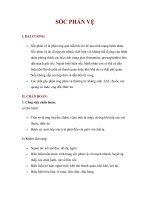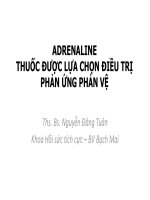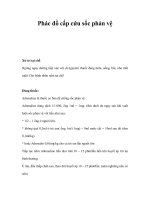ĐIỀU TRỊ SÔC PHẢN VỆ
Bạn đang xem bản rút gọn của tài liệu. Xem và tải ngay bản đầy đủ của tài liệu tại đây (530.37 KB, 31 trang )
ĐiỀU TRỊ SỐC PHẢN VỆ
Năm 2012
BS Phùng Nguyễn Thế Nguyên
Mục tiêu
1. Không chẩn đoán nhầm
2. Không điều trị sai.
Shock phản vệ
Lưu đồ điều trị
Dấu hiệu nặng
Adrenalin
- Alpha-receptor agonist: reverses peripheral vasodilation
and reduces oedema.
- Beta-receptor: dilates the bronchial airways, increases the
force of myocardial contraction, and suppresses histamine
and leukotriene release.
- Beta-2 adrenergic receptors on mast cells: inhibit
activation, and so early adrenaline attenuates the severity
of IgE-mediated allergic reactions.
Pamela w Ewan. Anaphylaxiis. BMJ. 1998. 316 (9).
Adrenaline
- Adrenaline seems to work best when given early after the
onset of the reaction.
- It is not without risk, particularly when given intravenously.
Adverse effects are extremely rare with correct doses
injected intramuscularly (IM).
Indication
- Adrenaline should be given to all patients with lifethreatening features.
- These features are absent but there are other features of a
systemic allergic reaction, the patient needs careful
observation and symptomatic treatment using the ABCDE
approach.
Delivery route of adrenaline
- Intramuscular (IM)
- Intravenous (IV)
- subcutaneous or inhaled
Intramuscular (IM) Adrenaline
- The intramuscular (IM) route is the best. several benefits:
Position: anterolateral aspect of the middle third of the
thigh
Repeat the IM adrenaline dose
- if there is no improvement in the patient’s condition.
Further doses can be given at about 5-minute intervals
according to the patient’s response.
Intravenous (IV) adrenaline (for
specialist use only)
Adrenaline in special populations
subcutaneous or inhaled route
- Not recommended for the treatment of an anaphylactic
reaction because they are less effective.









